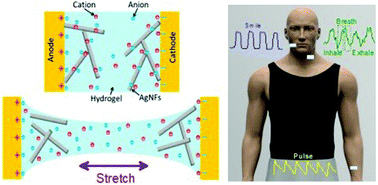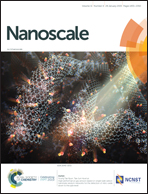An ultra-stretchable, highly sensitive and biocompatible capacitive strain sensor from an ionic nanocomposite for on-skin monitoring†
Abstract
Flexible strain sensors that can be comfortably attached onto the skin for real-time and accurate detection of physiological signals are particularly important for the realization of healthcare, soft robotics and human–machine interfacing. It is still challenging to develop strain sensors that satisfy both high stretchability and high sensitivity. Here, we demonstrate an ultra-stretchable, highly sensitive and biocompatible capacitive-type strain sensor based on a nanocomposite containing ionic hydrogels and silver nanofibers (AgNFs). The sensor exhibits an ultra-high stretchability of 1000% and high sensitivity with a maximum gauge factor (GF) of up to 165. We find that the incorporation of AgNFs greatly increases the electrical-double layer (EDL) area at the hydrogel/metal interface and hence enhances by 3 orders of magnitude the strain sensitivity. With a short response time and good operation stability, the sensor and its matrix were successfully applied to monitor various physiological signals such as arm and finger motions, pulse, electrocardiographs (ECG), breath, speaking and emotion changes.



 Please wait while we load your content...
Please wait while we load your content...